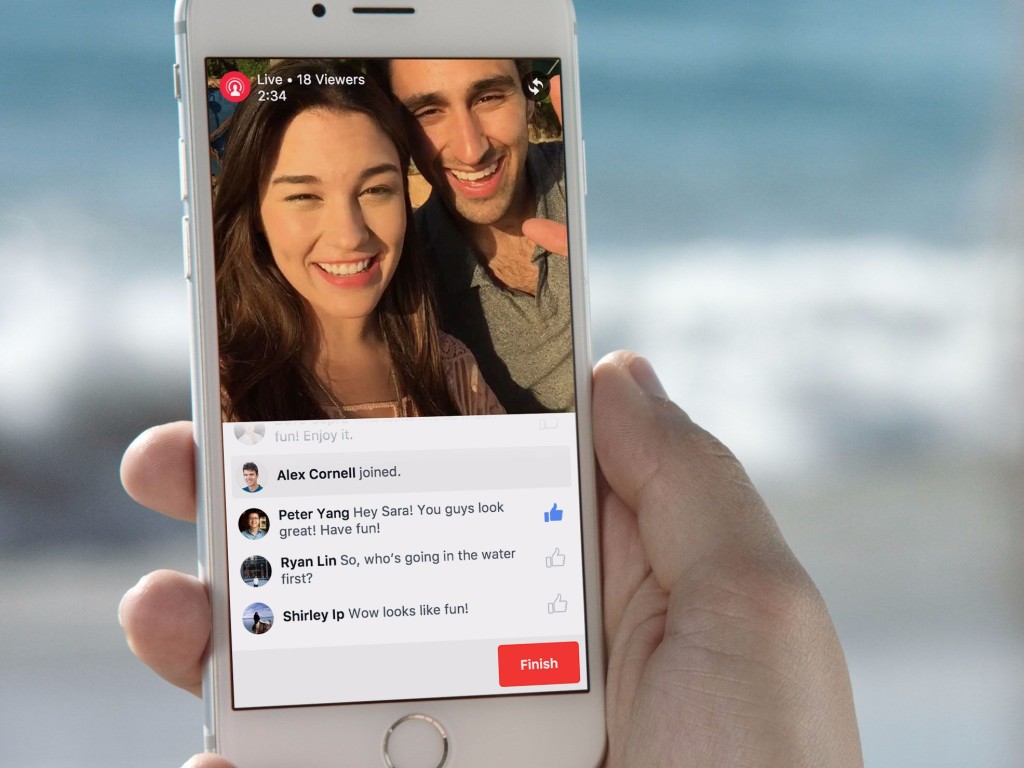Facebook Live launched initially in August of 2015 as a way for celebrities to broadcast video to their fans via Facebook pages. Early this year, the tool became available on Facebook’s mobile app. Now, Live Video is replacing the Messenger icon in the Facebook app on both iOS and Android.
Facebook is already getting some major market share with Live Video. Take a look at the numbers: Twitter launched its Periscope live video app nine months before Facebook did on mobile, and Twitter’s installed base is just a small fraction of Facebook’s (305 million monthly active users (MAU) compared to 1.44 billion MAU).
Why should Facebook be engaged in this effort? “People now expect communication that’s immediate, expressive and immersive,” said Paul Peterman, head of industry, global marketing solutions, Facebook & Instagram, speaking the [a]list summit. He went on to note that 1.4 billion people are using messaging apps, and over two billion will by 2018. Six of the 10 most used apps globally are messaging apps. “From a brand perspective, we have to live up to the expectation that there is immediate communication and what is that value that we can bring,” Peterman added.
Facebook Live Video is a logical place for advertising, and if Facebook can create a regular, large, dedicated audience for video, advertisers will stand up and take notice.
“Mobile isn’t just an emerging video platform, mobile is the video platform,” Peterman said. He pointed out a 616 percent growth in mobile videos from 2012 to 2015, and that almost half (45 percent) of global video views are now on mobile devices. Facebook sees eight billion daily video views and 100 million hours of video viewed daily, but those were on the News Feed which can be scrolled past easily. What if Facebook video was more like TV? Now you’re talking some real advertising potential.
How Facebook Is Driving Live Video
Facebook is paying some large publishers (like Vox Media) to create live video broadcasts for Facebook, which is one way to jumpstart the growth of Facebook Live Video. Participants include The New York Times, Buzzfeed, Huffington Post, and others, according to Re/code. Tastemade, the video network focused on food and travel content, is providing 100 live, exclusive videos per month.
Now that Facebook has opened up its News Feed to publishers, we can expect similar open arms for video content as well. “Facebook Live is an extremely sticky way to broadcast live video,” Peterman noted. “We’re early days, but we’re very excited about it.”
The Advertising Future for Facebook Live Video
The important part for both Facebook and publishers is the prospect not only of increased audience, but of deriving revenue from that audience—through advertising. Publishers can’t wait for this to happen, though Facebook is proceeding cautiously for now. “It’s tough for us to be patient because in the end all of these [broadcast windows] need dedicated resources,” said Mark Lopez, executive vice president of Univision Digital, speaking to Re/code. “If we use resources for Facebook Live that means those resources are not working on something else. So for us it’s pretty urgent that we can find paths to monetization.”
The consensus among publishers is that they expect Facebook to use interstitial ads rather than a pre-roll. That wouldn’t seem logical for short videos, but it makes perfect sense for a longer video—which is the bulk of what is being planned here.
Interactive Video Ads
Vast possibilities lie ahead for Facebook Live Video and advertising, and Facebook isn’t rushing ahead just yet. But other companies are moving forward, testing the waters—like Innovid, which is trying out online rollover ads with Facebook and Instagram.
Early tests have had some good results, like the campaign British tea and coffee brand Taylors of Harrogate ran last December. The 30-second spot featured a button in the corner of the screen, and if you pointed the mouse at it you’d have the chance to take quizzes, sign up for emails or buy products. The test showed that the format brought a 35 percent engagement rate with 4,400 likes, more than 250 comments and 400 shares.
“This is the first step in transforming social viewers into active participants,” said Tal Chalozin, Innovid’s co-founder and chief technology officer. “Facebook was a natural stepping stone for us because they’ve done an amazing job building a sophisticated ad platform that is continually reinventing itself. We are currently exploring other social platforms to see where interactive video experiences might also integrate well.”
Facebook is firmly committed to making video a key part of its experience, and it’s also looking to bring in publishers and content creators for all sorts of content—video, live video, as well as text. The advertising possibilities have yet to be detailed, but Facebook is no doubt hard at work in this area. The company has already demonstrated great strength in mobile advertising, and it seems like a good bet that Facebook will be among the leaders in bringing mobile advertising to the revenue levels that its audience deserves. Marketers of all types of products should be ready to jump in when advertising opportunities present themselves in Facebook Live Video.

